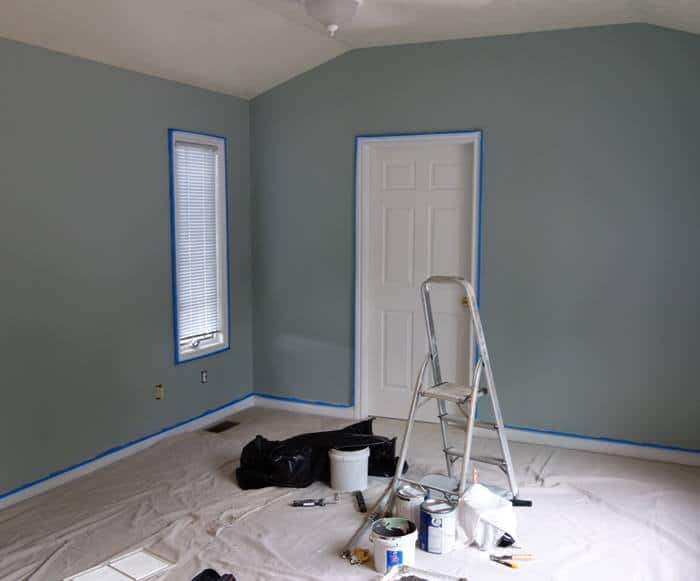A freshly painted room might take anything from 2 to 8 hours to dry. During and after drying, the
Regular oil
It is the best way to wait a week before sleeping in a closed bedroom. In the event of zero-VOC (Volatile Organic Compounds), you can sleep in the room for two to six hours after it has been painted.
Allow 72 Hours for Such Rooms to Settle Before Using Them
It is good news for children to sleep in a freshly painted room once the
Ventilating the room will help to force the VOCs out, making the space safe for vulnerable populations such as pregnant women, small children, elderly people, and pets.
Eschew Pregnant Women to Spend the Night in a Fresh Coat of Paint Room
Pregnant women should avoid napping in a fresh coat room, especially if oil-based
Short-term exposure during pregnancy, particularly during the first trimester may induce developmental issues in unborn infants and raise the chance of childhood leukemia.
Sleeping in a Freshly Painted Room is Fragile for Children
Aside from pregnant women, toddlers and newborns are also sensitive. However, young children do not have to sleep in a painted room for several days.
With new improvements and breakthroughs in
This is because the acrylic
During these hours, it is critical to air the freshly painted space. This ensures that all harmful fumes have been expelled throughout the drying painting process.
When the
Water-based paints dry rapidly, so plan on waiting three to four hours. However, not all common paints are made equal. Some may contain more harmful chemicals and require much time to dry.
That is why it is critical to understand the
Animals Must Never Nap in a Freshly Painted Home
Domestic pets that stay indoors all day, such as dogs, cats, or caged birds, should not be kept in freshly painted rooms since they are more likely than people to acquire health risks from off-gassing from the
Pets have a lower lung capacity, making them more susceptible to epidemics of respiratory disorders.
Because dogs can smell up to 100,000 sufficient times better than humans, even the smallest amount of
Even if you choose low-VOC
VOCs not only have adverse health effects, but they may also be fatal to tiny animals such as birds.
For 72 hours, Ventilate a Freshly Painted Room
To enhance indoor air quality, ventilate the room during the painting project and at least 72 hours afterward.
Opening the windows and doors, they bring in box fans and position them toward the open windows and doors to send airflow to the outside.
Proper ventilation allows fresh air to enter and drives VOCs out, allowing the house paints to dry faster.
Keep in mind that some professional painters include volatile compounds that take many days to evaporate even after the
The Most Hazardous Oil-Based Gloss Paint
Gloss paints used to be oil-based, which meant they emitted
Gloss paints are now water-based and fast-drying, with low-VOC content, owing to advances in
Such gloss paints provide less health danger than other different types of the
Zero-VOC paints or low-VOC paints are the safest
Get Rid of Paint Smell from a Room
Nobody enjoys the smell of a new
- Using fans and opening windows
- Turn off the heat or air conditioning.
- Leave buckets of water in the room overnight to absorb all the solvent
paint fumes. - Fill several bowls with white vinegar and place them in the room. They will also absorb vapors and remove toxic chemicals from allergic reactions and breathing conditions.
- Place basins of baking soda in various parts of the room to absorb wet paints.
- These are the five most efficient methods for removing
paint vapors and smells from a space. It will quickly remove the harsh chemicals, and you will be able to enjoy a safer alternative and healthy atmosphere. The most critical factor is adequate ventilation.
Related >> Why Does My House Smell Like Paint?
The Best Paints for Enchanting Homes
The safety of the
These are some examples:
1) Water-Based Paint
Water-based
Individuals choose this indoor
2) Oil-Based Paint
Oil-based
It provides a smooth finish and glossy surface that water-based
It is critical to ventilate the space while the
Otherwise, it will cause sinus discomfort, respiratory problems, immune system, central nervous system, runny nose, throat irritation, and possibly runny nose.
3) Low-VOC or Zero-VOC Paints
Low-VOC
Manufacturers of some versions of this
Paint Fume Removal Techniques
To eliminate
1) Select Low-VOC Paints for Indoor Area
Select water-based paints with a low-VOC level of 50 grams per cubic centimeter or less are typically used inside and emit less harmful compounds.
2) Firmly Remove Anything Residual Paint Containers
Close any unused
If you want to properly dispose of old
3) Scale-up the Amount of Ventilation in the Painting Area
Consider painting during dry weather and keeping the windows open during and after painting your room’s walls.
Box fans can assist guide airflow to the exterior. Even though the
To improve the quality of your indoor air, use air purifiers.
Conclusion
The
Simply wait an hour or two and allow some air fresheners to the space. However, this is only a precaution and is not required because the

